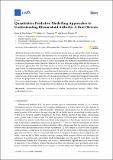Files in this item
Quantitative predictive modelling approaches to understanding rheumatoid arthritis : a brief review
Item metadata
| dc.contributor.author | Macfarlane, Fiona Ruth | |
| dc.contributor.author | Chaplain, Mark Andrew Joseph | |
| dc.contributor.author | Eftimie, Raluca | |
| dc.date.accessioned | 2020-01-06T16:30:04Z | |
| dc.date.available | 2020-01-06T16:30:04Z | |
| dc.date.issued | 2019-12-27 | |
| dc.identifier | 265382690 | |
| dc.identifier | 419e6de3-39ea-4da4-8c16-71005927b42e | |
| dc.identifier | 000515398200074 | |
| dc.identifier | 85090491128 | |
| dc.identifier.citation | Macfarlane , F R , Chaplain , M A J & Eftimie , R 2019 , ' Quantitative predictive modelling approaches to understanding rheumatoid arthritis : a brief review ' , Cells , vol. 9 , no. 1 , 74 . https://doi.org/10.3390/cells9010074 | en |
| dc.identifier.issn | 2073-4409 | |
| dc.identifier.uri | https://hdl.handle.net/10023/19230 | |
| dc.description.abstract | Rheumatoid arthritis is a chronic autoimmune disease that is a major public health challenge. The disease is characterised by inflammation of synovial joints and cartilage erosion, which lead to chronic pain, poor life quality and, in some cases, mortality. Understanding the biological mechanisms behind the progression of the disease, as well as developing new methods for quantitative predictions of disease progression in the presence/absence of various therapies is important for the success of therapeutic approaches. The aim of this study is to review various quantitative predictive modelling approaches for understanding rheumatoid arthritis. To this end, we start by briefly discussing the biology of this disease and some current treatment approaches, as well as emphasising some of the open problems in the field. Then, we review various mathematical mechanistic models derived to address some of these open problems. We discuss models that investigate the biological mechanisms behind the progression of the disease, as well as pharmacokinetic and pharmacodynamic models for various drug therapies. Furthermore, we highlight models aimed at optimising the costs of the treatments while taking into consideration the evolution of the disease and potential complications. | |
| dc.format.extent | 26 | |
| dc.format.extent | 2407740 | |
| dc.language.iso | eng | |
| dc.relation.ispartof | Cells | en |
| dc.subject | Rheumatoid arthritis | en |
| dc.subject | Mathematical models | en |
| dc.subject | Deterministic models | en |
| dc.subject | ODEs | en |
| dc.subject | PDEs | en |
| dc.subject | Probabilistic models | en |
| dc.subject | QA Mathematics | en |
| dc.subject | QH301 Biology | en |
| dc.subject | RC Internal medicine | en |
| dc.subject | T-NDAS | en |
| dc.subject | SDG 3 - Good Health and Well-being | en |
| dc.subject.lcc | QA | en |
| dc.subject.lcc | QH301 | en |
| dc.subject.lcc | RC | en |
| dc.title | Quantitative predictive modelling approaches to understanding rheumatoid arthritis : a brief review | en |
| dc.type | Journal item | en |
| dc.contributor.institution | University of St Andrews. School of Mathematics and Statistics | en |
| dc.contributor.institution | University of St Andrews. Applied Mathematics | en |
| dc.identifier.doi | https://doi.org/10.3390/cells9010074 | |
| dc.description.status | Peer reviewed | en |
This item appears in the following Collection(s)
Items in the St Andrews Research Repository are protected by copyright, with all rights reserved, unless otherwise indicated.

